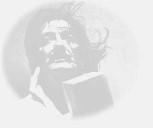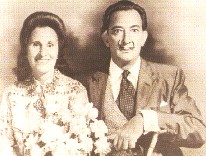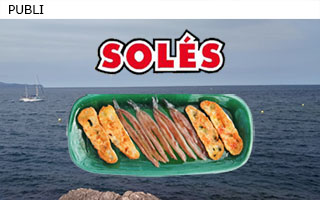Dalí, the Genius from Cadaqués

John Peter Moore, Ex Private Secretary of Salvador Dali looks back ( Interview from the year 1998)
While Picasso is referred to as the “most well known” artist of the XXth century, and Marc Chagall as the “most beloved”, Salvador Dali should certainly be given the title of “most important” artist of XXth century. In the centre Pompidou in Paris 1.25 mio visitors where registered in only four months, auction prices no living artist has ever reached, never-ending visitor queues at the Dali museum in Figueres, all this speaks for itself.
CapCreus Online spoke to Captain John Peter Moore former Dali manager who turned him into a wealthy man. Moore looks back onto a life full of variety: Irish by birth, brought up in France, met Churchill and Roosevelt whilst serving with British Intelligence. He was appointed officer of the Legion of Honour personally by de Gaulle, worked later in Rome as director of London Films together with the first garde in the film world e.g. Rosselini, Orson Wells, de Sica, David Lean.. and with stars like James Mason, Laurence Olivier and Grace Kelly. “But” according to Captain John Peter Moore, “the time with Dali was without any doubt the most interesting one in my life. We saw each other practically every day, spent summers in Cadaqués and winters in New York. Dali’s wife Gala, being Russian and needing the cold, loved the winters there. Dali is no Catalan name. I reckon that his ancestors were gypsies and looked after horses in the Fort of Figueres. His origin was an absolute tabu theme for Dali. His grandfather who already lived in Cadaqués allowed his father the training to become a notary. This surprised people in Cadaqués as the training was for 7 years and costs accordingly expensive. Dali’s father was the only notary in Figueres at that time and therefore knew a lot about the local people. He became quite wealthy but was also quite an eccentric. The sole wish of the notary and practising atheist (this was at the time quite unacceptable) was, that his son would one day take over his notary office. He quite acknowledged the talent of his son as an artist but was convinced that he could not make a living out of it.The young Dali stayed firm though, he did not want to end up in an office and sign papers day in day out.

Salvador Dali had been thoroughly prepared for his career as an artist. He was educated by Silesians, obtained a vast knowledge of French vocabulary and 15 years of art education. First in Figueres, then Girona, Barcelona and Madrid where he met his later friends as the film producer Lluis Bunuel and poet Federico Garcia Lorca. He was not very impressed by his tutors and commented that none of them were any good. Dali could just as well have become a film producer, writer or sculptor but he chose painting. He was not extremely motivated though and would have remained a local artist had Gala not entered his life. Gala arrived with her husband the writer Paul Eluard in Cadaqués to spend the summer there. Paul Eluard had constant affairs but Gala also had her share of pleasure, like sporadic “menage a trois” with Eluard and Max Ernst. Paul Eluard left Cadaqués for a galant rendezvous and Gala stayed behind with Dali to the horror of his family. The fact that she was 10 years his senior, Russian and divorced where even too much for his atheist, eccentric father and he stopped all financial support. Dali’s sister denounced Gala to the Guardia Civil as a whore and Dali never spoke to her again. Gala was used to a life of luxury by her origin and marriage to Paul Eluard. She did not join Dali as a poor woman but from her previous marriage she brought plenty of furniture, jewellery and clothes. Dali and Eluard remained friends. In the classical sense their marriage was never consummated as Dali was a voyeur and Gala liked young men, a fine match. Gala was mundane, extravagant and cosmopolitan. She loved luxury, loved Dali and he loved her. Her husband should get as famous and rich as his predecessor. There was another woman in his life though: Nanita, a married Kalaschnikow and Dior model. Her father, a writer, has written over 2000 cheap novels. When Dali was informed that Nanita had been taken ill, he went to Cadaqués church and prayed for 3 hours. Dali was religious and not at all anticlerical as has been stated occasionally. With Gala he started travelling As a result he had his first sales in Paris , financially not very interesting but the buyers were influential people. Jean Cocteau who never bought a painting before in his life acquired a Dali and passed it on to Picasso as a gift. On their first journey to New York they had their first dinner appointment with the Duke of Windsor and his wife Wallis Simpson. If you want to sell your paintings expensively it is better to know the Duke of Windsor than a peanut salesman. Dali had to sell because Gala needed money. Dali himself had a rather ambivalent sense for money. He only realised that in order to become world famous you have to know people with powerful influence. And where there is power there is money. One episode shows Dali’s sense of the dollar: Dali wanted to take a taxi from one hotel to another and needed money, so Gala gave him 100 dollars. On arrival he telephoned Gala to complain that he had no money left for the return journey. Her comment, he was supposed to pay the taxdriver and not buy the taxi. The solution to the puzzle: the taximeter showed 1.00 dollar and the taxi driver must have been overjoyed to receive a 100 dollar bill from Dali.
Captain John Peter Moore started working officially for Dali in 1962, who at this point was already famous but by no means rich; this would soon change. When Moore and Dali parted the latter was worth approx. 32 mio dollars. John Peter Moore: To enter the world of art dealers was not too difficult for me, since I knew the film scene the majority being Jewish similar to the art dealers scene. The world-wide success of Dali was based on three factors: his immense talent, Gala’s influence and not least his enormous drive and creativity. We practically saw each other every day. Often I came to his house at 9 am and Dali was standing in front of his easel with paintbrush in hand. Same scene at 9 pm with paints spread around everywhere and Gala fuming as she had dressed up to go to the casino (she liked gambling). but Dali refused to stop painting. Then of course the couple’s eccentricity played a great role as well. Somehow exceptional events drew them like magnets.
One day a hotel porter informed me that a woman would like to speak to Gala without giving her name. It was Josef Stalin’s daughter Swetlana and Gala was not quite sure of the situation but dressed up and received her. Without this little routine she never showed herself in public. In general Gala was basically a media shy person although always being in the limelight of the public. She hardly spoke any Spanish and her Catalan was just sufficient to instruct the house staff. Dali and Gala’s communication was in French.
And now back to Swetlana. She literally poured out a load of Russian and Gala asked her to speak in French as having left Russia a very long time ago she had no complete command of the language any more. Referring to her Russian this was not correct. She only wanted me to be able to follow the conversation. The outcome was that Swetlana came to Gala for advise and would only trust a fellow Russian. She had received from an American publishing company 1 million dollars for her memoires and did not know what to do with the money. I finally invested it for her in Liechtenstein. Galas question, why had she actually left Russia describes the tragic circumstances of her life. Swetlana, with her 40 years still a beautiful woman, literally said: “My father has killed my mother and he wanted to kill me as well.” Swetlana Stalin had then spent her life drifting between capitalism and communism. She married an architect in America but could not cope with the capitalism, returned to Russia and there could not cope with the communism either. Today she lives in England. Stories after stories about Gala and Dali, Dali and Gala, these will amongst other things be the theme of the book I am just finishing being about 800 pages long. Much has been written about this couple and always will. A lot is positive and acceptable but more very negative and simply untrue. In any case I can recommend the art connaisseur to read Dali’s own book “ma vie secret” (my secret life). Why did we finally go different ways? I had a very complicated operation in Paris and my reconvalescence took a very long time. Dali needed someone else to look after his commercial side; whether he took the right decision I somehow doubt. When I left Salvador Dali he was a rich man, when he died he was in debts. My opinion also is that to spend such a long time with a genius is a gift of fate but on the other hand also very trying. I have at least spent the time with him when he was at his peak creativity. 70 years old and up till then in best health Dali also had to undergo an operation which did not turn out positively. After that Dali declined physically and mentally day by day. But to call this his “tragic end” as this has been the case on a tv documentary in quite a spectacular way last year I found rather unesthetic. I feel that this documentation was extremely anti-Daliesk and has unfortunately followed the negative media trend: for the sake of selling and against one’s better judgement making things negative. A great pity and injust. Millions of people in the next century or in a 1000 years will appreciate Dali’s work. A whole generation of artists will be able to gain from it.
CapCreus online: “Captain John Peter Moore, we thank you very much for this interview.”

